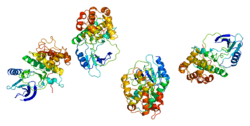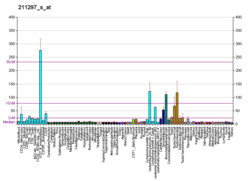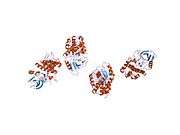Cyclin-dependent kinase 7
Cyclin-dependent kinase 7, or cell division protein kinase 7, is an enzyme that in humans is encoded by the CDK7 gene.[4]
The protein encoded by this gene is a member of the cyclin-dependent protein kinase (CDK) family. CDK family members are highly similar to the gene products of Saccharomyces cerevisiae cdc28, and Schizosaccharomyces pombe cdc2, and are known to be important regulators of cell cycle progression.
This protein forms a trimeric complex with cyclin H and MAT1, which functions as a Cdk-activating kinase (CAK). It is an essential component of the transcription factor TFIIH, that is involved in transcription initiation and DNA repair. This protein is thought to serve as a direct link between the regulation of transcription and the cell cycle.[5]
Clinical significance eg cancer
Given that CDK7 is involved in two important regulation roles, it’s expected that CDK7 regulation may play a role in cancerous cells. Cells from breast cancer tumors were found to have elevated levels of CDK7 and Cyclin H when compared to normal breast cells. It was also found that the higher levels were generally found in ER-positive breast cancer. Together, these findings indicate that CDK7 therapy might make sense for some breast cancer patients.[6] Further confirming these findings, recent research indicates that inhibition of CDK7 may be an effective therapy for HER2-positive breast cancers, even overcoming therapeutic resistance. THZ1 was tested on HER2-positive breast cancer cells and exhibited high potency for the cells regardless of their sensitivity to HER2 inhibitors. This finding was demonstrated in vivo, where inhibition of HER2 and CDK7 resulted in tumor regression in therapeutically resistant HER2+ xenograft models.[7]
Inhibitors
The growth suppressor p53 has been shown to interact with cyclin H both in vitro and in vivo. Addition of wild type p53 was found to heavily downregulated CAK activity, resulting in decreased phosphorylation of both CDK2 and CTD by CDK7. Mutant p53 was unable to downregulate CDK7 activity and mutant p21 had no effect on downregulation, indicating that p53 is responsible for negative regulation of CDK7.[8]
In 2017 CT7001, an oral CDK7 inhibitor, started a phase 1 clinical trial.[9]
THZ1 is an inhibitor for CDK7 that selectively forms a covalent bond with the CDK7-cycH-MAT1 complex. This selectivity stems from forming a bond at C312, which is unique to CDK7 within the CDK family. CDK12 and CDK13 could also be inhibited using THZ1 (but at higher concentrations) because they have similar structures in the region surrounding C312 [10]. It was found that treatment of 250 nM THZ1 was sufficient to inhibit global transcription and that cancer cell lines were sensitive to much lower concentrations, opening up further research into the efficacy of using THZ1 as a component of cancer therapy, as described above.
In renal cell carcinoma (RCC), the expression of CDK7 was significantly higher in the advanced stage tumors. Besides, the overall survival was significantly shorter in patients with higher CDK7 expression in the tumors. These results suggest that CDK7 may be a potential target for overcoming RCC. [11]
Interactions
Cyclin-dependent kinase 7 has been shown to interact with:
See also
References
- ENSG00000277273 GRCh38: Ensembl release 89: ENSG00000134058, ENSG00000277273 - Ensembl, May 2017
- "Human PubMed Reference:". National Center for Biotechnology Information, U.S. National Library of Medicine.
- "Mouse PubMed Reference:". National Center for Biotechnology Information, U.S. National Library of Medicine.
- Fisher RP, Morgan DO (August 1994). "A novel cyclin associates with MO15/CDK7 to form the CDK-activating kinase". Cell. 78 (4): 713–24. doi:10.1016/0092-8674(94)90535-5. PMID 8069918.
- "Entrez Gene: CDK7 cyclin-dependent kinase 7 (MO15 homolog, Xenopus laevis, cdk-activating kinase)".
- Patel H, Abduljabbar R, Lai CF, Periyasamy M, Harrod A, Gemma C, et al. (December 2016). "Expression of CDK7, Cyclin H, and MAT1 Is Elevated in Breast Cancer and Is Prognostic in Estrogen Receptor-Positive Breast Cancer". Clinical Cancer Research. 22 (23): 5929–5938. doi:10.1158/1078-0432.CCR-15-1104. PMC 5293170. PMID 27301701.
- Sun B, Mason S, Wilson RC, Hazard SE, Wang Y, Fang R, et al. (January 2020). "Inhibition of the transcriptional kinase CDK7 overcomes therapeutic resistance in HER2-positive breast cancers". Oncogene. 39 (1): 50–63. doi:10.1038/s41388-019-0953-9. PMC 6937212. PMID 31462705.
- Schneider E, Montenarh M, Wagner P (November 1998). "Regulation of CAK kinase activity by p53". Oncogene. 17 (21): 2733–41. doi:10.1038/sj.onc.1202504. PMID 9840937.
- ...first patient dosed in phase 1 clinical trial of its oral CDK7 inhibitor: CT7001 2017
- Kwiatkowski N, et al. (2014). "Targeting transcription regulation in cancer with a covalent CDK7 inhibitor". Nature. 511 (7511): 616. doi:10.1038/nature13393. PMC 4244910. PMID 25043025.
- Chow PM, Liu SH, Chang YW, Kuo KL, Lin WC, Huang KH (February 2020). "The covalent CDK7 inhibitor THZ1 enhances temsirolimus-induced cytotoxicity via autophagy suppression in human renal cell carcinoma". Cancer Letters. 471: 27–37. doi:10.1016/j.canlet.2019.12.005. PMID 31812697.
- Lee DK, Duan HO, Chang C (March 2000). "From androgen receptor to the general transcription factor TFIIH. Identification of cdk activating kinase (CAK) as an androgen receptor NH(2)-terminal associated coactivator". The Journal of Biological Chemistry. 275 (13): 9308–13. doi:10.1074/jbc.275.13.9308. PMID 10734072.
- Yee A, Nichols MA, Wu L, Hall FL, Kobayashi R, Xiong Y (December 1995). "Molecular cloning of CDK7-associated human MAT1, a cyclin-dependent kinase-activating kinase (CAK) assembly factor". Cancer Research. 55 (24): 6058–62. PMID 8521393.
- Mäkelä TP, Tassan JP, Nigg EA, Frutiger S, Hughes GJ, Weinberg RA (September 1994). "A cyclin associated with the CDK-activating kinase MO15". Nature. 371 (6494): 254–7. Bibcode:1994Natur.371..254M. doi:10.1038/371254a0. PMID 8078587.
- Garber ME, Mayall TP, Suess EM, Meisenhelder J, Thompson NE, Jones KA (September 2000). "CDK9 autophosphorylation regulates high-affinity binding of the human immunodeficiency virus type 1 tat-P-TEFb complex to TAR RNA". Molecular and Cellular Biology. 20 (18): 6958–69. doi:10.1128/mcb.20.18.6958-6969.2000. PMC 88771. PMID 10958691.
- Rossignol M, Kolb-Cheynel I, Egly JM (April 1997). "Substrate specificity of the cdk-activating kinase (CAK) is altered upon association with TFIIH". The EMBO Journal. 16 (7): 1628–37. doi:10.1093/emboj/16.7.1628. PMC 1169767. PMID 9130708.
- Shiekhattar R, Mermelstein F, Fisher RP, Drapkin R, Dynlacht B, Wessling HC, et al. (March 1995). "Cdk-activating kinase complex is a component of human transcription factor TFIIH". Nature. 374 (6519): 283–7. Bibcode:1995Natur.374..283S. doi:10.1038/374283a0. PMID 7533895.
- Talukder AH, Mishra SK, Mandal M, Balasenthil S, Mehta S, Sahin AA, et al. (March 2003). "MTA1 interacts with MAT1, a cyclin-dependent kinase-activating kinase complex ring finger factor, and regulates estrogen receptor transactivation functions". The Journal of Biological Chemistry. 278 (13): 11676–85. doi:10.1074/jbc.M209570200. PMID 12527756.
- Ko LJ, Shieh SY, Chen X, Jayaraman L, Tamai K, Taya Y, et al. (December 1997). "p53 is phosphorylated by CDK7-cyclin H in a p36MAT1-dependent manner". Molecular and Cellular Biology. 17 (12): 7220–9. doi:10.1128/mcb.17.12.7220. PMC 232579. PMID 9372954.
- Giglia-Mari G, Coin F, Ranish JA, Hoogstraten D, Theil A, Wijgers N, et al. (July 2004). "A new, tenth subunit of TFIIH is responsible for the DNA repair syndrome trichothiodystrophy group A". Nature Genetics. 36 (7): 714–9. doi:10.1038/ng1387. PMID 15220921.
Further reading
- Jeang KT (1998). "Tat, Tat-associated kinase, and transcription". Journal of Biomedical Science. 5 (1): 24–7. doi:10.1007/BF02253352. PMID 9570510.
- Yankulov K, Bentley D (June 1998). "Transcriptional control: Tat cofactors and transcriptional elongation". Current Biology. 8 (13): R447-9. doi:10.1016/S0960-9822(98)70289-1. PMID 9651670.
- Shiekhattar R, Mermelstein F, Fisher RP, Drapkin R, Dynlacht B, Wessling HC, et al. (March 1995). "Cdk-activating kinase complex is a component of human transcription factor TFIIH". Nature. 374 (6519): 283–7. Bibcode:1995Natur.374..283S. doi:10.1038/374283a0. PMID 7533895.
- Aprelikova O, Xiong Y, Liu ET (August 1995). "Both p16 and p21 families of cyclin-dependent kinase (CDK) inhibitors block the phosphorylation of cyclin-dependent kinases by the CDK-activating kinase". The Journal of Biological Chemistry. 270 (31): 18195–7. doi:10.1074/jbc.270.31.18195. PMID 7629134.
- Serizawa H, Mäkelä TP, Conaway JW, Conaway RC, Weinberg RA, Young RA (March 1995). "Association of Cdk-activating kinase subunits with transcription factor TFIIH". Nature. 374 (6519): 280–2. Bibcode:1995Natur.374..280S. doi:10.1038/374280a0. PMID 7885450.
- Tassan JP, Schultz SJ, Bartek J, Nigg EA (October 1994). "Cell cycle analysis of the activity, subcellular localization, and subunit composition of human CAK (CDK-activating kinase)". The Journal of Cell Biology. 127 (2): 467–78. doi:10.1083/jcb.127.2.467. PMC 2120215. PMID 7929589.
- Darbon JM, Devault A, Taviaux S, Fesquet D, Martinez AM, Galas S, et al. (November 1994). "Cloning, expression and subcellular localization of the human homolog of p40MO15 catalytic subunit of cdk-activating kinase". Oncogene. 9 (11): 3127–38. PMID 7936635.
- Williams RT, Wu L, Carbonaro-Hall DA, Hall FL (October 1994). "Identification, assay, and purification of a Cdc2-activating threonine-161 protein kinase from human cells". Archives of Biochemistry and Biophysics. 314 (1): 99–106. doi:10.1006/abbi.1994.1416. PMID 7944411.
- Mäkelä TP, Tassan JP, Nigg EA, Frutiger S, Hughes GJ, Weinberg RA (September 1994). "A cyclin associated with the CDK-activating kinase MO15". Nature. 371 (6494): 254–7. Bibcode:1994Natur.371..254M. doi:10.1038/371254a0. PMID 8078587.
- Levedakou EN, He M, Baptist EW, Craven RJ, Cance WG, Welcsh PL, et al. (July 1994). "Two novel human serine/threonine kinases with homologies to the cell cycle regulating Xenopus MO15, and NIMA kinases: cloning and characterization of their expression pattern". Oncogene. 9 (7): 1977–88. PMID 8208544.
- Wu L, Yee A, Liu L, Carbonaro-Hall D, Venkatesan N, Tolo VT, Hall FL (July 1994). "Molecular cloning of the human CAK1 gene encoding a cyclin-dependent kinase-activating kinase". Oncogene. 9 (7): 2089–96. PMID 8208556.
- Yee A, Nichols MA, Wu L, Hall FL, Kobayashi R, Xiong Y (December 1995). "Molecular cloning of CDK7-associated human MAT1, a cyclin-dependent kinase-activating kinase (CAK) assembly factor". Cancer Research. 55 (24): 6058–62. PMID 8521393.
- Blau J, Xiao H, McCracken S, O'Hare P, Greenblatt J, Bentley D (May 1996). "Three functional classes of transcriptional activation domain". Molecular and Cellular Biology. 16 (5): 2044–55. doi:10.1128/MCB.16.5.2044. PMC 231191. PMID 8628270.
- Bartkova J, Zemanova M, Bartek J (June 1996). "Expression of CDK7/CAK in normal and tumor cells of diverse histogenesis, cell-cycle position and differentiation". International Journal of Cancer. 66 (6): 732–7. doi:10.1002/(SICI)1097-0215(19960611)66:6<732::AID-IJC4>3.0.CO;2-0. PMID 8647641.
- Reardon JT, Ge H, Gibbs E, Sancar A, Hurwitz J, Pan ZQ (June 1996). "Isolation and characterization of two human transcription factor IIH (TFIIH)-related complexes: ERCC2/CAK and TFIIH". Proceedings of the National Academy of Sciences of the United States of America. 93 (13): 6482–7. Bibcode:1996PNAS...93.6482R. doi:10.1073/pnas.93.13.6482. PMC 39049. PMID 8692841.
- Drapkin R, Le Roy G, Cho H, Akoulitchev S, Reinberg D (June 1996). "Human cyclin-dependent kinase-activating kinase exists in three distinct complexes". Proceedings of the National Academy of Sciences of the United States of America. 93 (13): 6488–93. Bibcode:1996PNAS...93.6488D. doi:10.1073/pnas.93.13.6488. PMC 39050. PMID 8692842.
- Zhou Q, Sharp PA (October 1996). "Tat-SF1: cofactor for stimulation of transcriptional elongation by HIV-1 Tat". Science. 274 (5287): 605–10. Bibcode:1996Sci...274..605Z. doi:10.1126/science.274.5287.605. PMID 8849451.
- Parada CA, Roeder RG (November 1996). "Enhanced processivity of RNA polymerase II triggered by Tat-induced phosphorylation of its carboxy-terminal domain". Nature. 384 (6607): 375–8. Bibcode:1996Natur.384..375P. doi:10.1038/384375a0. PMID 8934526.
- García-Martínez LF, Ivanov D, Gaynor RB (March 1997). "Association of Tat with purified HIV-1 and HIV-2 transcription preinitiation complexes". The Journal of Biological Chemistry. 272 (11): 6951–8. doi:10.1074/jbc.272.11.6951. PMID 9054383.
External links
- CDK7+protein,+human at the US National Library of Medicine Medical Subject Headings (MeSH)
- CDK7 human gene location in the UCSC Genome Browser.
- CDK7 human gene details in the UCSC Genome Browser.
- Overview of all the structural information available in the PDB for UniProt: P50613 (Cyclin-dependent kinase 7) at the PDBe-KB.




